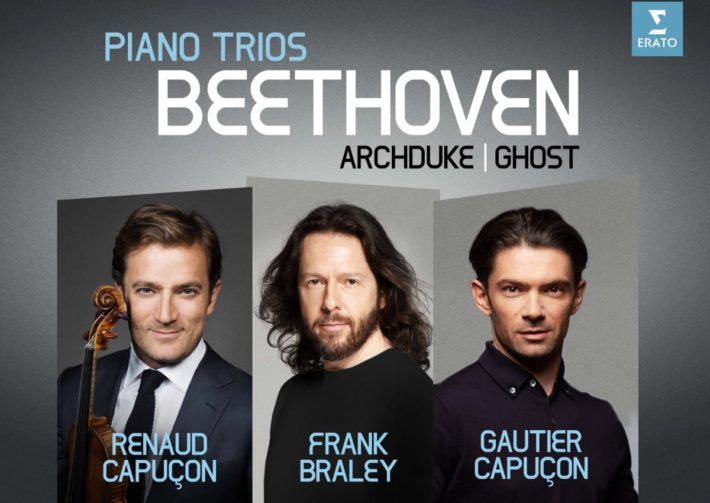These three musicians are no strangers to Beethoven. Pianist Frank Braley recorded the complete Cello Sonatas with Gautier Capuçon (2016) and released a recording of the complete Violin Sonatas with brother Renaud on Erato back in 2010.
The group presents an elegant interpretation of the Op. 70 No. 1 trio, also known as “Ghost”. What stands out in the first movement is the ensemble balance, credited especially to Brayley, who plays with refined clarity and conscious restraint so as not to overpower the strings. Stylistic coordination is also strong here: the ensemble is noticeably consistent in terms of its articulation and phrasing and the handoffs of melodic lines and accompaniment figures are seamless. I did however wished, on some moments in the opening bars, for the cello line to come forward even more, as the phrase itself has an inviting nature to it. The quiet sections of the first movement do tend to sound flat at times; better phrase contouring across all instruments might have helped in this regard. An interesting comparison worth considering is the Beaux Arts Trio’s famous 1960s recording; it’s curious to note how the brisk tempo taken, and a less legato articulation, change the character of the movement. Where the new performance is lyrical, the Beaux Arts Trio’s is raw, toeing the line of exciting unpredictability.
The second movement (from where the trio supposedly got its nickname) is defined by contrasts: eerie moments are juxtaposed against impassioned bursts. The ensemble’s performance possesses a similar nuanced quality seen in the prior movement, but what it needs is a stronger sense of mystery to enhance this contrast and perpetuate the movement’s dynamism. Here turn to Jacqueline du Pre, Pinchas Zuckerman, and Daniel Barenboim: bow control of the strings is so even and devoid of vibrato that it captures the ominous whispering of the lines; the slower tempo also helps in giving the movement a dirge-like quality. Gautier Capuçon’s playing is particularly strong in this movement, but Renaud’s violin sounds a little thin throughout. One reason for this is a consistent lack of sufficient vibrato – while indeed necessary for moments like the monophonic opening, more of it in the more melodic spots would have given the playing additional body and expression, consistent with the piano and cello.
Related Classical Music Reviews
- Review: Franck and Chopin – Cello Sonatas – Gautier Capuçon, Yuja Wang
- Review: Gautier Capuçon Plays Schumann
- Review: Beethoven – Late String Quartets – Brodsky Quartet
The trio’s interpretation of the “Archduke Trio” has some of the fine qualities of the “Ghost” but the weaknesses are somewhat enhanced. Particularly salient here is the ensemble’s proclivity toward cautious musical choices, which robs the work of the multidimensionality of character the piece possesses. The first movement’s opening drags compared to other versions (Rubinstein/Heifetz/Feuermann 1942 recording comes to mind), its slower tempo and the articulation interpreted as Molto Sostenuto. The movement, however, does show nice dynamic control and attention to Beethoven’s harmonic color changes. And Gautier’s playing again shines through, especially in the upper register, his instrument speaks with a rich sound quality. Shame that Renaud doesn’t do the same: as in the previous trio, his playing sounds thin due to light-handedness in the bowing (listen to 7’52” – 8’12” where there is a mismatch between the strings in this regard).
The Scherzo is charming, not always in a good way: it misses the impishly playful spirit that would otherwise capture the listener’s attention all the way through. Predictability sets-in quickly, which is problematic in a movement structured around repetition: there need to be more shifts in character between sections, as in the sprightly B-flat major and the undulating, chromatic sections, which seem somewhat lethargic. The third movement moves too quickly where it should take more time: the piano opening, as it’s written, shows Beethoven at his most profound and evocative (though the “Andante cantabile ma però con moto” instruction does not make a more animated tempo out of the question). The version here is the quickest from the others mentioned above but for Rubinstein, who compensates for the fast opening with his usual backboned sound. These qualities are wanting in Brayley’s approach, which sets the tone for the other members of the ensemble as well. The final movement, though not as vibrant as others, is a good finish, with the players capturing its rhythmic buoyancy, keeping light and intimate proportions even in the minor-key segments, where others took a more weighty approach.
The sound engineering gives a chance to be in close proximity to the ensemble. Overall, these performances are solid but not the strongest in character: collectors who are looking for more energy or edge might find that it pales in comparison to other versions in the catalog.

Beethoven – Piano Trios Op. 70 No. 1 (“Ghost”) and Op. 97 (“Archduke”).
Renaud Capuçon – Violin
Gautier Capuçon – Cello
Frank Braley – Piano
Erato / Warner Classics, CD 9029539199
Albums Mentioned In This Review
Read more classical music reviews or visit The Classic Review Amazon store
Follow Us and Comment:
Get our periodic classical music newsletter with our recent reviews, news and beginners guides.
We respect your privacy.









